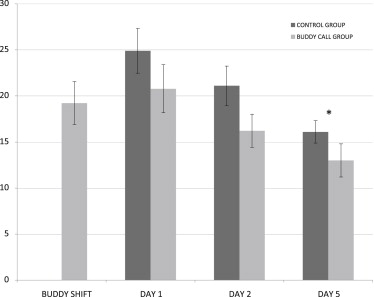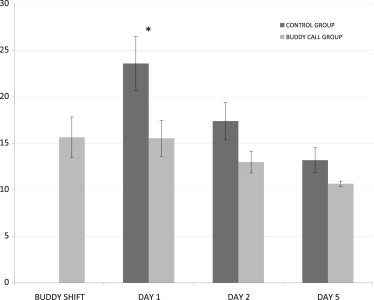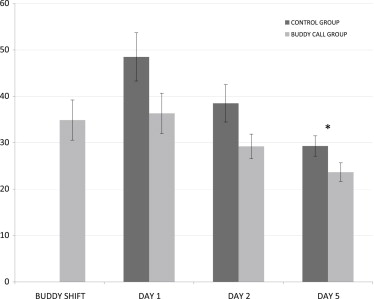Rationale and Objectives
The aims of this study were to quantify resident anxiety when beginning independent call and to assess whether an apprenticeship experience (buddy call) can lessen anxiety and improve confidence.
Materials and Methods
A prospective cohort comparison of two groups of radiology residents beginning independent call, one of which was provided with a buddy call experience, was performed. Anxiety and confidence were assessed using the Endler Multidimensional Anxiety Scales–State (EMAS-S), with total score, autonomic emotional, and cognitive worry components, and a five-point, Likert-type scale, respectively. Both groups were asked about the perceived value of a buddy call experience.
Results
EMAS-S scores improved significantly over 5 days of call in both groups (control, n = 10, P = .0005; buddy call, n = 9, P = .0001), and image interpretation confidence correspondingly increased (control, P = .0004; buddy call, P = .003). Compared to the control group, autonomic emotional scores were significantly lower in the buddy call group on the first day of independent call ( P = .040), and cognitive worry and total EMAS-S scores were significantly lower on day 5 (both P values = .03). Buddy call was independently associated with improved autonomic emotional and film interpretation confidence scores (both P values = .02). All members of the buddy call group indicated that the experience was very helpful in preparing for call.
Conclusions
Beginning independent call is associated with high anxiety, and buddy call reduces that anxiety, beyond the effect of time alone. Residents who participated in buddy call found it helpful in preparing for independent call. These findings support the use of buddy call and tiered call structures as means to introduce junior residents to independent call.
Residency is stressful. The impact of the stresses faced by residents has been well documented, with several studies showing high levels of depression and anxiety among residents and worsening mood over the course of residency . Resident stress has also been demonstrated to have negative physiologic effects and to have an adverse impact on job performance . One of the most stressful components of residency is overnight call. Trainees are expected to operate increasingly independently, and the limits of their knowledge and organizational skills are tested. Despite the high stress associated with overnight call, the call experience is a necessary and valuable part of residency training, as it allows residents to make independent decisions and to develop confidence in their skills.
Anecdotally, senior residents report that the stresses of call diminish with time. Despite this natural acclimatization, some residency programs can also provide support for junior residents at the beginning of their call experience to reduce the initial stress. Clinical residencies may support junior residents by scheduling them for call with senior residents, knowing that the availability of a more experienced colleague for consultation can provide security for junior trainees. Similarly, some radiology residencies have adopted a model in which junior residents work alongside senior residents before they begin independent call (a “buddy call” system). Although a preliminary apprenticeship may ease the transition to independent call, it is resource intensive, because several residents are assigned to perform a task that might be accomplished by a single trainee. To our knowledge, there are no published data that demonstrate whether such apprenticeship experiences reduce resident stress during subsequent independent call.
Get Radiology Tree app to read full this article<
Get Radiology Tree app to read full this article<
Get Radiology Tree app to read full this article<
Materials and methods
Get Radiology Tree app to read full this article<
Get Radiology Tree app to read full this article<
Get Radiology Tree app to read full this article<
Get Radiology Tree app to read full this article<
Get Radiology Tree app to read full this article<
Get Radiology Tree app to read full this article<
Get Radiology Tree app to read full this article<
Get Radiology Tree app to read full this article<
Control Group
Get Radiology Tree app to read full this article<
Buddy Call Group
Get Radiology Tree app to read full this article<
Statistical Analysis
Get Radiology Tree app to read full this article<
Results
Demographics
Get Radiology Tree app to read full this article<
Control Group
Get Radiology Tree app to read full this article<
Table 1
Anxiety Scores for the Control (No Buddy Call) and Buddy Call Groups as Assessed by the Endler Multidimensional Anxiety Scales–State
Anxiety Domain Call Day Control group ( n = 10) Buddy Call Day 1 Day 2 Day 5 Autonomic emotional Mean score 23.6 17.4 13.2 95% CI 17.0–30.2 12.8–22.0 10.2–16.2 Percentile 88 69 52 Cognitive worry Mean score 24.9 21.1 16.1 95% CI 19.4–30.4 16.3–25.9 13.4–18.8 Percentile 91 82 71 Total score Mean score 48.5 38.5 29.3 95% CI 36.8–60.2 29.4–47.6 24.4–34.2 Percentile 91 79 65
Buddy call group ( n = 9) Autonomic emotional Mean score 15.7 15.6 13.0 10.7 95% CI 10.7–20.6 11.2–19.9 10.3–15.7 10.0–11.3 Percentile 62 69 54 32 Cognitive worry Mean score 19.2 20.8 16.2 13.0 95% CI 14.0–24.5 14.9–26.7 12.2–20.3 8.9–17.1 Percentile 76 79 66 43 Total score Mean score 34.9 36.3 29.2 23.7 95% CI 25.1–44.7 26.5–46.2 23.2–35.2 19.1–28.2 Percentile 73 77 62 39
CI, confidence interval.
Get Radiology Tree app to read full this article<
Get Radiology Tree app to read full this article<
Get Radiology Tree app to read full this article<
Table 2
Confidence in Interpretive and Procedural Skills
Confidence Call Day Control group ( n = 10) Buddy Call Day 1 Day 2 Day 5 Plain radiographic interpretation Mean score 2.5 3.0 3.5 95% CI 2.0–3.0 2.4–3.6 3.0–4.0 Fluoroscopic LP Mean score 2.4 2.5 2.5 95% CI 1.4–3.4 1.6–3.4 1.5–3.5 Fluoroscopic joint aspiration Mean score 2.8 3.0 2.9 95% CI 1.9–3.7 2.2–3.8 2.2–3.6 Fluoroscopic GI study Mean score 2.9 3.5 3.5 95% CI 2.2–3.6 3.0–4.0 2.9–4.1
Buddy call group (n = 9) Plain radiographic interpretation Mean score 2.4 3.2 3.7 4.1 95% CI 1.9–3.0 2.7–3.7 3.3–4.0 3.7–4.6 Fluoroscopic LP Mean score 2.1 2.4 2.7 2.8 95% CI 1.0–3.2 1.4–3.4 1.7–3.6 1.7–3.9 Fluoroscopic joint aspiration Mean score 2.3 2.9 3.3 3.7 95% CI 1.4–3.3 2.3–3.5 2.6–4.1 3.0–4.3 Fluoroscopic GI study Mean score 3.3 3.6 3.7 3.7 95% CI 2.3–4.3 2.8–4.3 2.9–4.4 2.8–4.5
CI, confidence interval; GI, gastrointestinal; LP, lumbar puncture.
Get Radiology Tree app to read full this article<
Get Radiology Tree app to read full this article<
Buddy Call Group
Get Radiology Tree app to read full this article<
Get Radiology Tree app to read full this article<
Get Radiology Tree app to read full this article<
Get Radiology Tree app to read full this article<
Differences Between Groups
Get Radiology Tree app to read full this article<
Table 3
Statistical Significance of Comparison of Control and Buddy Call Group Scores at Each Time Point
Measure Statistical Significance ( P ) Day 1 Day 2 Day 5 First Shift ∗ Cognitive worry .2672 .1693 .0258 † .1121 Autonomic emotional .0402 † .1346 .1202 .0469 † Total EMAS-S score .1110 .1094 .0262 † .0632 Film confidence .0543 .0848 .0880 .8679 LP confidence .8340 .8359 .8004 .6680 Joint confidence 1.000 .6141 .1429 .4193 GI confidence .2616 .7618 .6528 .4277
EMAS-S, endler multidimensional anxiety scales–state; GI, gastrointestinal; LP, lumbar puncture.
Get Radiology Tree app to read full this article<
Get Radiology Tree app to read full this article<
Get Radiology Tree app to read full this article<
Get Radiology Tree app to read full this article<
Time and Buddy Call Effects
Get Radiology Tree app to read full this article<
Table 4
Multivariate Analysis of Time and Buddy Call Effects on Anxiety and Confidence Scores
Measure Statistical Significance Buddy Call Effect Time Effect Day 1 to 2 Day 2 to 5 Day 1 to 5 Cognitive worry .14 <.0001 ∗ .001 ∗ .001 ∗ <.0001 ∗ Autonomic emotional .02 ∗ <.0001 ∗ .02 ∗ .09 <.0001 ∗ Total EMAS-S score .057 <.0001 ∗ .003 ∗ .01 ∗ <.0001 ∗ Film confidence .02 ∗ <.0001 ∗ .007 ∗ .007 ∗ <.0001 ∗ Joint confidence .37 .01 ∗ .09 .70 .02 ∗
EMAS-S, endler multidimensional anxiety scales–state.
Get Radiology Tree app to read full this article<
Get Radiology Tree app to read full this article<
Get Radiology Tree app to read full this article<
Subjective Value of a Buddy Call Experience
Get Radiology Tree app to read full this article<
Get Radiology Tree app to read full this article<
Discussion
Get Radiology Tree app to read full this article<
Get Radiology Tree app to read full this article<
Get Radiology Tree app to read full this article<
Get Radiology Tree app to read full this article<
Get Radiology Tree app to read full this article<
Get Radiology Tree app to read full this article<
Get Radiology Tree app to read full this article<
Get Radiology Tree app to read full this article<
Get Radiology Tree app to read full this article<
Get Radiology Tree app to read full this article<
Get Radiology Tree app to read full this article<
Get Radiology Tree app to read full this article<
Get Radiology Tree app to read full this article<
Get Radiology Tree app to read full this article<
Get Radiology Tree app to read full this article<
Appendix A
Additional Survey, Day 5 (Experimental Group)
Get Radiology Tree app to read full this article<
1 2 3 4 5 Very Unsure Somewhat Unsure Neutral Somewhat Confident Very Confident
Get Radiology Tree app to read full this article<
Get Radiology Tree app to read full this article<
1 2 3 4 5 Very Unsure Somewhat Unsure Neutral Somewhat Confident Very Confident
Get Radiology Tree app to read full this article<
Get Radiology Tree app to read full this article<
1 2 3 4 5 Very Unsure Somewhat Unsure Neutral Somewhat Confident Very Confident
Get Radiology Tree app to read full this article<
Get Radiology Tree app to read full this article<
1 2 3 4 5 Very Unsure Somewhat Unsure Neutral Somewhat Confident Very Confident
Get Radiology Tree app to read full this article<
Get Radiology Tree app to read full this article<
Get Radiology Tree app to read full this article<
Get Radiology Tree app to read full this article<
1 2 3 Somewhat Helpful Very Helpful Extremely Helpful
Get Radiology Tree app to read full this article<
Appendix B
Resident Accuracy Assessment
Get Radiology Tree app to read full this article<
Get Radiology Tree app to read full this article<
Get Radiology Tree app to read full this article<
Get Radiology Tree app to read full this article<
Get Radiology Tree app to read full this article<
Get Radiology Tree app to read full this article<
Get Radiology Tree app to read full this article<
Get Radiology Tree app to read full this article<
References
1. Gordon G.H., Hubbell F.A., Wyle F.A., et. al.: Stress during internship: a prospective study of mood states. J Gen Intern Med 1986; 1: pp. 228-231.
2. Schneider S.E., Phillips W.M.: Depression and anxiety in medical, surgical, and pediatric interns. Psychol Rep 1993; 72: pp. 1145-1146.
3. Zare S.M., Galanko J., Behrns K.E., et. al.: Psychological well-being of surgery residents before the 80-hour work week: a multiinstitutional study. J Am Coll Surg 2004; 198: pp. 633-640.
4. Feddock C.A., Hoellein A.R., Wilson J.F., et. al.: Do pressure and fatigue influence resident job performance?. Med Teach 2007; 29: pp. 495-497.
5. Goetz T., Preckel F., Zeidner M., et. al.: Big fish in big ponds: a multilevel analysis of test anxiety and achievement in special gifted classes. Anxiety Stress Coping 2008; 21: pp. 185-198.
6. Mehler P.S., Anderson R.J.: Mechanism of pressor response in medical house officers on call. Ann Intern Med 1987; 106: pp. 560-561.
7. Tendulkar A.P., Victorino G.P., Chong T.J., et. al.: Quantification of surgical resident stress “on call.”. J Am Coll Surg 2005; 201: pp. 560-564.
8. Endler N.S., Edwards J.M., Vitelli R.: Endler multidimensional anxiety scales manual.1991.Western Psychological ServicesLos Angeles, CA
9. Orton D.I., Gruzelier J.H.: Adverse changes in mood and cognitive performance of house officers after night duty. BMJ 1989; 298: pp. 21-23.
10. Berkoff K., Rusin W.: Pediatric house staff’s psychological response to call duty. J Dev Behav Pediatr 1991; 12: pp. 6-10.
11. Esterl R.M., Henzi D.L., Cohn S.M.: Senior medical student “boot camp”: can result in increased self-confidence before starting surgery internships. Curr Surg 2006; 63: pp. 264-268.
12. Peyre S.E., Peyre C.G., Sullivan M.E., et. al.: A surgical skills elective can improve student confidence prior to internship. J Surg Res 2006; 133: pp. 11-15.
13. Towbin A.J., Paterson B., Chang P.J.: A computer-based radiology simulator as a learning tool to help prepare first-year residents for being on call. Acad Radiol 2007; 14: pp. 1271-1283.
14. Joffe S.A., Burak J.S., Rackson M., et. al.: The effect of international teleradiology attending radiologist coverage on radiology residents’ perceptions of night call. J Am Coll Radiol 2006; 3: pp. 872-878.


